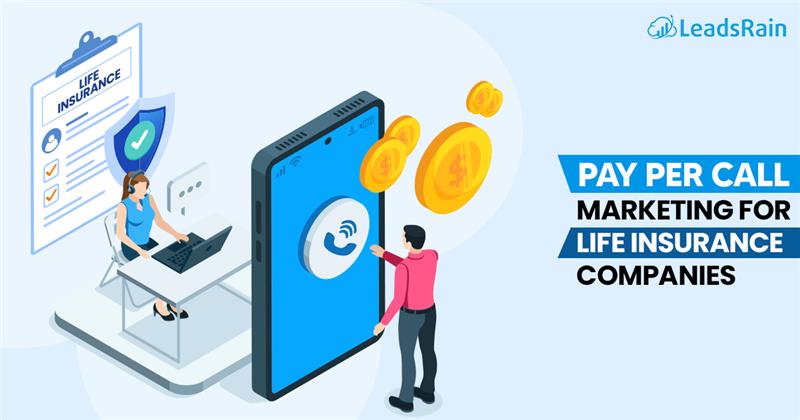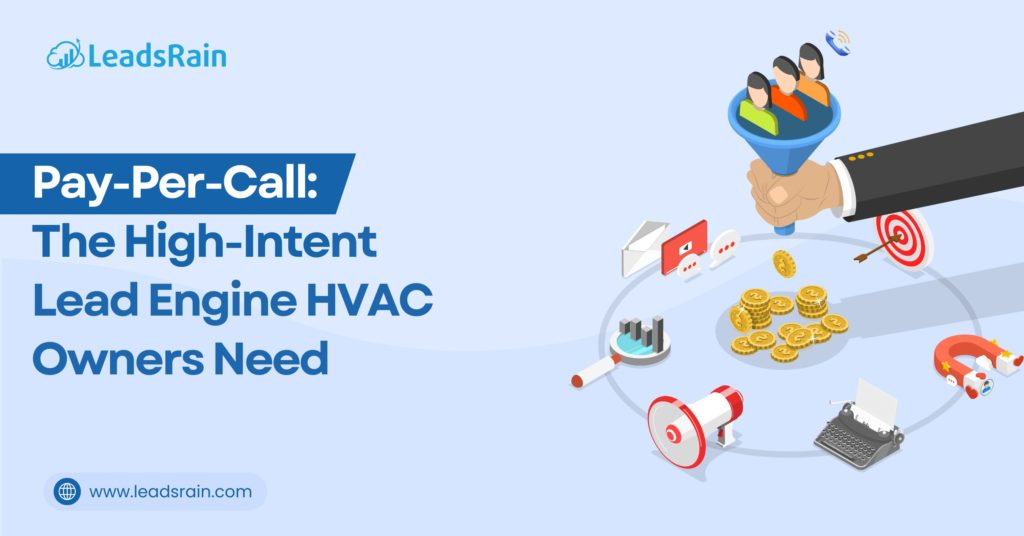Life insurance is one of the most relationship-driven industries out there. Consumers aren’t just buying a product—they’re securing their family’s future. In such a high-trust, high-stakes market, timing and conversation are everything. That’s why Pay Per Call (PPC) marketing has become a game-changer for life insurance companies looking to connect with ready-to-buy leads in real time.
But what exactly is Pay Per Call marketing? How does it work for life insurance carriers, agents, or brokers? And is it worth the investment?
Let’s break it all down.
Why is Pay Per Call a Perfect Fit for Life Insurance?
Life insurance isn’t a product people pick up on a whim. It’s a deeply personal decision tied to family, finances, and future planning. Most buyers want clarity, reassurance, and real human interaction before committing. This is exactly where pay per call shines.
When someone picks up the phone to speak to a life insurance agent, they’re not browsing casually. They’re usually facing a life moment—starting a family, buying a house, or planning ahead—and they want answers now. Pay per call bridges that urgency with live, immediate conversations.
Here’s a breakdown of why it’s such a powerful strategy for life insurance companies:
Consumers want real conversations before they buy
Life insurance policies can be complex. Buyers want to know what they’re getting, how much it will cost, and how it protects their loved ones. They don’t want to rely on online quotes or wait for email follow-ups. They want to talk to someone who can explain everything clearly and give them confidence in their choice.
Pay per call creates space for that conversation. When someone dials in, they’re signaling they’re ready to engage, ask questions, and possibly make a decision during the call itself.
It captures intent at the perfect time
When someone searches for a life insurance quote or clicks on an ad offering help with coverage options, there’s a strong buying signal. Pay per call campaigns are designed to connect with these individuals the moment they’re actively seeking help.
Instead of losing them to a form or delayed response, the call connects them with an agent instantly. That real-time interaction keeps the momentum going and gives agents the best shot at closing the sale while interest is fresh.
Personalized service leads to better results
No two insurance shoppers are exactly alike. One caller may be a new parent looking for a term policy. Another might be a retiree comparing final expense coverage. Phone calls give agents the opportunity to listen, personalize, and guide the conversation based on each person’s unique situation.
That level of customization builds trust and increases the chances of converting the lead into a policyholder. It’s hard to replicate that level of engagement through forms or automated systems.
These aren’t cold leads—you’re not chasing anyone
Chasing down form leads, getting voicemail after voicemail, or hearing “I’m not interested” gets old fast. Pay per call flips the process completely. You’re answering calls from people who want to speak with you. That changes the entire tone of the conversation.
With pay per call, you don’t waste time or money on leads that go nowhere. Instead, you only pay for calls that match your campaign criteria, like location, call length, or type of insurance interest.
Works well for both solo agents and large teams
Whether you’re an individual agent working remotely or part of a large call center with multiple licensed agents, pay per call adapts easily. Calls can be routed by state, language, product type, or agent availability, making sure the right person handles the right lead.
This flexibility means the same model can scale as your business grows, without having to rework your entire system.
Helps you stay compliant and clean
Regulatory issues in insurance marketing are a constant concern. Pay per call helps reduce risk because the customer initiates the interaction. You’re not sending unsolicited messages or buying lists that may not be TCPA compliant.
Call recordings, tracking numbers, and pre-screened traffic sources give you a solid paper trail if needed. This kind of transparency and control helps you market more confidently.
Easy to scale up without sacrificing quality
Once your campaign is working well and your team is handling calls efficiently, increasing volume is simple. More calls can be generated by expanding your ad placements, working with additional call publishers, or increasing your budget. You still stay in control of your daily caps, targeting, and lead filters.
Unlike many other lead sources, the pay per call model gives you predictable, real-time leads you can scale without hurting performance.
How Pay Per Call Works in Life Insurance Campaigns?
Pay per call campaigns follow a structured flow that connects potential life insurance buyers directly with licensed agents. Each step is designed to maximize lead quality, ensure compliance, and improve conversion rates. Here’s how the process works:
1. Campaign Setup
The first step involves defining campaign goals and call criteria. Life insurance companies or agencies outline their:
- Target audience (based on age, location, income, etc.)
- Desired call duration to count as a billable lead
- Operating hours and agent availability
- Product types (such as term, whole, or final expense insurance)
All campaign details are documented, including compliance guidelines and tracking systems to monitor performance.
2. Traffic Generation
To generate inbound calls, marketers or publishers drive traffic through digital channels such as:
- Search engine ads with click-to-call functionality
- Mobile display ads
- Call-focused landing pages
- Offline methods like radio or direct mail with tracking numbers
Each method directs qualified users to a phone number that routes to the designated insurance sales center or agent.
3. Call Tracking and Routing
All inbound calls are tracked through a unique phone number tied to the campaign. When a call comes in:
- The system records call metadata (duration, time, source, etc.)
- Call routing logic determines which agent or center receives the call based on criteria like state licensing or availability
- Real-time routing ensures the caller is connected to the most relevant licensed professional
Advanced systems may also apply filters like call time, caller location, and language preferences.
4. Qualification and Filtering
To ensure lead quality, most campaigns include filters that allow only specific calls to be counted and billed. These filters may include:
- Minimum call duration (e.g., 60 or 90 seconds)
- Geographic restrictions
- Call time during business hours only
Calls that don’t meet these criteria may be discarded or not charged, protecting the buyer from low-quality leads.
5. Real-Time Agent Interaction
Once connected, the caller speaks directly with a licensed insurance agent. The agent collects essential details, qualifies the lead further, and discusses policy options. This is where the conversion opportunity takes place.
Call recordings and outcomes are often tracked for quality assurance, compliance, and performance optimization.
6. Call Attribution and Billing
Every qualified call that meets the predefined campaign rules is counted as a billable event. Detailed call logs and reporting dashboards allow the advertiser to:
- See where calls originated
- Monitor which publishers or sources are performing best
- Understand which time slots or keywords drive the highest intent
Advertisers only pay for the calls that match their campaign requirements.
7. Ongoing Optimization
Once the campaign is running, data is continuously monitored to improve results. Adjustments can be made to:
- Targeting parameters
- Call handling processes
- Traffic sources
- Ad creatives or landing pages
This step ensures that both the cost per acquisition and overall lead quality improve over time.
Tips to Make Your Pay Per Call Campaigns Thrive
A well-run pay per call campaign can become your most consistent source of high-intent life insurance leads. But to make it truly profitable, you need more than just call volume—you need strategy, structure, and attention to performance.
From targeting the right audience to handling every call like gold, small improvements can lead to big gains in conversions and ROI.
Here are some proven tips to help you get the most out of your campaigns:
- Set clear filters for call duration, location, and availability
- Use dedicated phone numbers for each traffic source to track performance
- Optimize landing pages and ad copy for call-driven actions
- Train agents to qualify and convert within the first 60 seconds
- Monitor call recordings regularly for quality assurance
- Adjust bids and budget based on peak-performing times and sources
- Test different campaigns for term, whole life, and final expense products
- Keep daily caps and targeting rules updated to avoid wasted spend
- Use real-time reporting tools to make fast, informed decisions
- Focus on compliance at every step—from creatives to call handling
Summing it up
Pay per call marketing offers a powerful way for life insurance companies to reach people at the exact moment they’re ready to have a real conversation. It cuts through the noise, delivers high-intent leads, and gives your team the chance to speak directly with individuals who are already in the decision-making mindset.
If you’re ready to explore how this can work for your business or need help setting up a winning campaign, feel free to reach out. Our team is happy to support you—just drop us a message at support@leadsrain.com.




